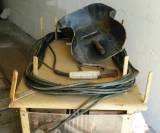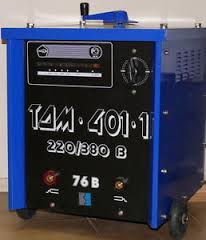Rules for the operation of welding transformers
 Before starting welding work using transformers, it is necessary to adhere to the typical safety rules: check the grounding, the absence of bare wires, the reliability of fastening with bolts, screws and contact connections, the presence and correct fastening of protective covers, and the absence of damages. This check should be done daily.
Before starting welding work using transformers, it is necessary to adhere to the typical safety rules: check the grounding, the absence of bare wires, the reliability of fastening with bolts, screws and contact connections, the presence and correct fastening of protective covers, and the absence of damages. This check should be done daily.
Before putting a new transformer into operation, it is necessary to store it again, remove the grease, blow it with air, check the insulation resistance, ground the transformer case (to the «Earth» bolt), check the compliance of the voltage in the network and the transformer. It is connected to the network using switches and fuses.
The welding transformer must be installed away from heat sources and not allowed to operate with overload to avoid overheating of the transformer and damage to the insulation of its windings.It is also necessary to protect against moisture penetration, otherwise insulation failure and turn-to-turn shorting may occur. Usually, transformers work at a temperature of -45 ... + 40 degrees, but the operating conditions must be checked according to the technical characteristics of the device in accordance with its climatic design.
The ends of the working cable must not touch each other, the end of the return wire and the electrode holder must not simultaneously touch the structure to be welded during operation.

The welding mode is set using the current switch, its handle must be moved to the stop when the machine is disconnected from the mains.
Once a month, you should check the insulation resistance between the secondary and primary windings and the housing, the insulation between the windings, having previously turned off the capacitor to suppress radio interference. If the insulation resistance does not meet the nominal value, it is necessary to dry the transformer with warm air and measure it again. You should also blow out the transformer to clean the core and winding from dust and dirt, check the condition of the contacts and, if necessary, clean them of plaque. The screw of the movable core element should be treated with refractory grease on a monthly basis.
It is also necessary to lubricate the seats of the transformer wheels, the bearings of the switches, the surfaces of the moving coils. This service is performed every six months.
It is recommended to check the operation of the capacitor for radio interference every three months and replace it if necessary.
The most common faults in welding transformers are the following:
1. Strong heating of the transformer. This can happen due to incorrect connection of the primary winding to the network, excess current, short circuit between turns of the coil, damage to the insulation between the steel sheets of the core. The heating of the clamps is caused by a weak tightening of the fasteners or a reduced cross-section of the wire in contact.
2. The increased noise level of the transformer is related to the loosening of the bolt connections, tightening of the core, uneven fastening of the core or winding mechanism, or due to the failure of the insulation between the windings and the transformer case.
3. The adjustment limit is not provided. This may be due to incomplete movement of the coils due to lead screw jamming or foreign objects falling between the core and the winding.
After repairing the welding transformer, it is necessary to recheck the open circuit voltage, the current adjustment interval and prepare it for operation. See also: Electrical safety in the production of electric welding

